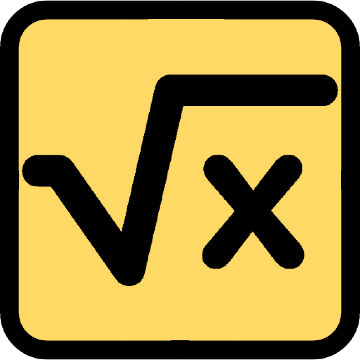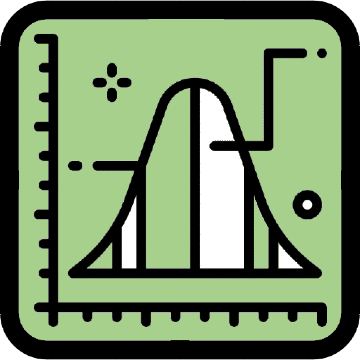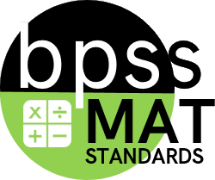MAT-06.AR  MAT-06.AR MAT-06.AR Domain  | (AR) Number and Operations Learners will develop a foundational understanding of the number system, operations, and computational fluency to create connections and solve problems within and across concepts.
|
Sub-Categories- (OA) Operations and Algebraic Thinking
Learners will analyze patterns and relationships to generate and interpret numerical expressions. - (RP) Ratios and Proportional Relationships
Learners will use ratios, rates, and proportions to model relationships and solve problems. - (EE) Expressions and Equations
Learners will look for, generate, and make sense of patterns, relationships, and algebraic symbols to represent mathematical models while adapting approaches in novel situations.
- (F) Functions
Learners will develop a foundational knowledge of functions and use them to model relationships between quantities.
Calculation Method for DomainsDomains are larger groups of related standards. The Domain Grade is a calculation of all the related standards. Click on the standard name below each Domain to access the learning targets and rubrics/ proficiency scales
for individual standards within the domain. |
|
MAT-06.AR.EE.01

|
6th Grade (MAT) Targeted Standard
(AR) Algebraic Reasoning
(EE) Expressions and Equations
Learners will look for, generate, and make sense of patterns, relationships, and algebraic symbols to represent mathematical models while adapting approaches in novel situations.
|
MAT-06.AR.EE.01 Read, write, and evaluate numerical expressions including expressions with whole number exponents and grouping symbols.*
 Proficiency Scale Proficiency Scale
Progressions
Equations/Expressions
- MAT-01.AR.OA.06 Use the +, -, and = symbols accurately in an equation.
- MAT-02.AR.OA.02 Apply the properties of operations to solve addition and subtraction equations and justify thinking.
- MAT-03.AR.OA.02 Apply the properties of operations to solve multiplication and division equations and justify thinking.
- MAT-03.AR.OA.03 Solve word two-step authentic word problems using addition and subtraction within 1000, including equations with a letter as an unknown.
- MAT-03.AR.OA.04 Use strategies and visual models to solve authentic word problems with multiplication within 100, including unknowns, using grouping models and equations.
- MAT-03.AR.OA.05 Use strategies and visual models to solve authentic word problems with division within 100, including unknowns, using grouping models and equations.
- MAT-04.AR.OA.03 Solve multi-step authentic word problems using the four operations, including problems with interpreted remainders.
- MAT-04.AR.OA.05 Interpret multiplication equations as a comparison. Represent multiplicative comparisons as multiplication equations.
- MAT-05.AR.OA.02 Analyze problems using the order of operations to solve and evaluate expressions while justifying thinking.
- MAT-05.AR.OA.03 Write simple expressions that record calculations with numbers. Interpret numerical expressions without evaluating them.
- MAT-06.AR.EE.01 Write, read, and evaluate numerical expressions, including expressions with whole number exponents and grouping symbols.
- MAT-06.AR.EE.02 Read and evaluate algebraic expressions, including expressions with whole number exponents and grouping symbols. Write algebraic expressions to represent simple and authentic situations.
- MAT-06.AR.EE.04 Describe the concept of a solution of an equation or an inequality. Determine whether a given number is a solution to an equation or an inequality.
- MAT-06.AR.EE.05 Write and solve equations of the form of x + p = q and px = q for cases in which p and q are non-negative whole numbers or decimals, including authentic problems.
- MAT-07.AR.EE.02 Write and solve equations of the form px + q = r and p(x + q) = r , including in authentic problems.
- MAT-08.AR.EE.01 Explain the relationship between repeated multiplication and the properties of integer exponents. Apply a single exponent property to generate equivalent numeric and algebraic expressions that include numerical coefficients.
- MAT-08.AR.EE.02 Use square root and cube root symbols to represent solutions to equations of the form x² = p and x³ = p, where p is a non-negative rational number.
- MAT-08.AR.EE.06 Read, write, and evaluate numerical and algebraic expressions, including expressions involving absolute value. Solve and graph equations of the form |x| = r where r is a nonnegative rational number.
- MAT-09.AR.01 Use the structure of an expression (i.e., quadratic and exponential) to identify ways to rewrite it.
- MAT-09.AR.04 Create linear and exponential equations in two or more variables to represent relationships between quantities. Graph equations on coordinate axes with appropriate labels and scales.
- MAT-12.AR.03 Interpret expressions that represent a quantity in context.
- MAT-12.AR.02 Use the structure of an expression (to extend to polynomial and rational expressions) to identify ways to rewrite it.
|
|
MAT-06.AR.EE.02

|
6th Grade (MAT) Targeted Standard
(AR) Algebraic Reasoning
(EE) Expressions and Equations
Learners will look for, generate, and make sense of patterns, relationships, and algebraic symbols to represent mathematical models while adapting approaches in novel situations.
|
MAT-06.AR.EE.02 Read and evaluate algebraic expressions, including expressions with whole number exponents and grouping symbols. Write algebraic expressions to represent simple and authentic situations.*
 Proficiency Scale Proficiency Scale
Progressions
Equations/Expressions
- MAT-01.AR.OA.06 Use the +, -, and = symbols accurately in an equation.
- MAT-02.AR.OA.02 Apply the properties of operations to solve addition and subtraction equations and justify thinking.
- MAT-03.AR.OA.02 Apply the properties of operations to solve multiplication and division equations and justify thinking.
- MAT-03.AR.OA.03 Solve word two-step authentic word problems using addition and subtraction within 1000, including equations with a letter as an unknown.
- MAT-03.AR.OA.04 Use strategies and visual models to solve authentic word problems with multiplication within 100, including unknowns, using grouping models and equations.
- MAT-03.AR.OA.05 Use strategies and visual models to solve authentic word problems with division within 100, including unknowns, using grouping models and equations.
- MAT-04.AR.OA.03 Solve multi-step authentic word problems using the four operations, including problems with interpreted remainders.
- MAT-04.AR.OA.05 Interpret multiplication equations as a comparison. Represent multiplicative comparisons as multiplication equations.
- MAT-05.AR.OA.02 Analyze problems using the order of operations to solve and evaluate expressions while justifying thinking.
- MAT-05.AR.OA.03 Write simple expressions that record calculations with numbers. Interpret numerical expressions without evaluating them.
- MAT-06.AR.EE.01 Write, read, and evaluate numerical expressions, including expressions with whole number exponents and grouping symbols.
- MAT-06.AR.EE.02 Read and evaluate algebraic expressions, including expressions with whole number exponents and grouping symbols. Write algebraic expressions to represent simple and authentic situations.
- MAT-06.AR.EE.04 Describe the concept of a solution of an equation or an inequality. Determine whether a given number is a solution to an equation or an inequality.
- MAT-06.AR.EE.05 Write and solve equations of the form of x + p = q and px = q for cases in which p and q are non-negative whole numbers or decimals, including authentic problems.
- MAT-07.AR.EE.02 Write and solve equations of the form px + q = r and p(x + q) = r , including in authentic problems.
- MAT-08.AR.EE.01 Explain the relationship between repeated multiplication and the properties of integer exponents. Apply a single exponent property to generate equivalent numeric and algebraic expressions that include numerical coefficients.
- MAT-08.AR.EE.02 Use square root and cube root symbols to represent solutions to equations of the form x² = p and x³ = p, where p is a non-negative rational number.
- MAT-08.AR.EE.06 Read, write, and evaluate numerical and algebraic expressions, including expressions involving absolute value. Solve and graph equations of the form |x| = r where r is a nonnegative rational number.
- MAT-09.AR.01 Use the structure of an expression (i.e., quadratic and exponential) to identify ways to rewrite it.
- MAT-09.AR.04 Create linear and exponential equations in two or more variables to represent relationships between quantities. Graph equations on coordinate axes with appropriate labels and scales.
- MAT-12.AR.03 Interpret expressions that represent a quantity in context.
- MAT-12.AR.02 Use the structure of an expression (to extend to polynomial and rational expressions) to identify ways to rewrite it.
|
|
MAT-06.AR.EE.05

|
6th Grade (MAT) Targeted Standard
(AR) Algebraic Reasoning
(EE) Expressions and Equations
Learners will look for, generate, and make sense of patterns, relationships, and algebraic symbols to represent mathematical models while adapting approaches in novel situations.
|
MAT-06.AR.EE.05 Write and solve equations of the form x + p = q and px = q for cases in which p and q are non-negative whole numbers or decimals, including authentic problems.*
 Proficiency Scale Proficiency Scale
Progressions
Equations/Expressions
- MAT-01.AR.OA.06 Use the +, -, and = symbols accurately in an equation.
- MAT-02.AR.OA.02 Apply the properties of operations to solve addition and subtraction equations and justify thinking.
- MAT-03.AR.OA.02 Apply the properties of operations to solve multiplication and division equations and justify thinking.
- MAT-03.AR.OA.03 Solve word two-step authentic word problems using addition and subtraction within 1000, including equations with a letter as an unknown.
- MAT-03.AR.OA.04 Use strategies and visual models to solve authentic word problems with multiplication within 100, including unknowns, using grouping models and equations.
- MAT-03.AR.OA.05 Use strategies and visual models to solve authentic word problems with division within 100, including unknowns, using grouping models and equations.
- MAT-04.AR.OA.03 Solve multi-step authentic word problems using the four operations, including problems with interpreted remainders.
- MAT-04.AR.OA.05 Interpret multiplication equations as a comparison. Represent multiplicative comparisons as multiplication equations.
- MAT-05.AR.OA.02 Analyze problems using the order of operations to solve and evaluate expressions while justifying thinking.
- MAT-05.AR.OA.03 Write simple expressions that record calculations with numbers. Interpret numerical expressions without evaluating them.
- MAT-06.AR.EE.01 Write, read, and evaluate numerical expressions, including expressions with whole number exponents and grouping symbols.
- MAT-06.AR.EE.02 Read and evaluate algebraic expressions, including expressions with whole number exponents and grouping symbols. Write algebraic expressions to represent simple and authentic situations.
- MAT-06.AR.EE.04 Describe the concept of a solution of an equation or an inequality. Determine whether a given number is a solution to an equation or an inequality.
- MAT-06.AR.EE.05 Write and solve equations of the form of x + p = q and px = q for cases in which p and q are non-negative whole numbers or decimals, including authentic problems.
- MAT-07.AR.EE.02 Write and solve equations of the form px + q = r and p(x + q) = r , including in authentic problems.
- MAT-08.AR.EE.01 Explain the relationship between repeated multiplication and the properties of integer exponents. Apply a single exponent property to generate equivalent numeric and algebraic expressions that include numerical coefficients.
- MAT-08.AR.EE.02 Use square root and cube root symbols to represent solutions to equations of the form x² = p and x³ = p, where p is a non-negative rational number.
- MAT-08.AR.EE.06 Read, write, and evaluate numerical and algebraic expressions, including expressions involving absolute value. Solve and graph equations of the form |x| = r where r is a nonnegative rational number.
- MAT-09.AR.01 Use the structure of an expression (i.e., quadratic and exponential) to identify ways to rewrite it.
- MAT-09.AR.04 Create linear and exponential equations in two or more variables to represent relationships between quantities. Graph equations on coordinate axes with appropriate labels and scales.
- MAT-12.AR.03 Interpret expressions that represent a quantity in context.
- MAT-12.AR.02 Use the structure of an expression (to extend to polynomial and rational expressions) to identify ways to rewrite it.
|
|
MAT-06.AR.RP.02

|
6th Grade (MAT) Targeted Standard
(AR) Algebraic Reasoning
(RP) Ratios and Proportional Relationships
Learners will use ratios, rates, and proportions to model relationships and solve problems.
|
MAT-06.AR.RP.02 Describe and calculate a unit rate when given a ratio relationship between two quantities using rate language and visual models.*
 Proficiency Scale Proficiency Scale
Progressions
Unit Rate
- MAT-06.AR.RP.02 Describe and calculate a unit rate when given a ratio relationship between two quantities using rate language and visual models.
- MAT-06.AR.RP.05 Convert measurement units within and between measurement systems using ratio reasoning given conversion factors.
- MAT-06.AR.RP.04 Calculate a percent of a quantity as a rate per 100. Solve problems involving finding the whole, given a part, and the percent.
- MAT-07.AR.RP.01 Calculate unit rates associated with ratios of rational numbers, including ratios of lengths, areas, and other quantities measured in like or different units.
- MAT-09.NO.03 Choose and interpret the scale and the units in graphs and data displays.
- MAT-09.NO.04 Define appropriate quantities and units for the purpose of descriptive modeling.
- MAT-09.AR.F.05 Calculate and interpret the average rate of change of a function (presented symbolically or as a table) over a specified interval. Estimate the rate of change from a graph.
- MAT-09.AR.F.06 Write a function defined by an expression in different but equivalent forms to reveal and explain the different properties of the function.
- MAT-12.NO.04 Use units to understand problems and to guide the solution of multi-step problems (e.g., unit analysis). Choose and interpret units consistently in formulas. Choose and interpret the scale and the units in graphs and data displays.
- MAT-12.AR.F.02 Calculate and interpret the average rate of change of a function (presented symbolically or as a table) over a specified interval. Estimate the rate of change from a graph.
|
|
MAT-06.AR.RP.04

|
6th Grade (MAT) Targeted Standard
(AR) Algebraic Reasoning
(RP) Ratios and Proportional Relationships
Learners will use ratios, rates, and proportions to model relationships and solve problems.
|
MAT-06.AR.RP.04 Calculate a percent of a quantity as a rate per 100. Solve problems using ratio reasoning involving finding the whole when given a part and the percent.*
 Proficiency Scale Proficiency Scale
Progressions
Percents
- MAT-06.AR.RP.04 Calculate a percent of a quantity as a rate per 100. Solve problems using ratio reasoning involving finding the whole when given a part and the percent.
- MAT-07.AR.RP.04 Use proportional relationships to solve multi-step problems involving ratios, percents, and scale drawings of geometric figures, including authentic problems.
Unit Rate
- MAT-06.AR.RP.02 Describe and calculate a unit rate when given a ratio relationship between two quantities using rate language and visual models.
- MAT-06.AR.RP.05 Convert measurement units within and between measurement systems using ratio reasoning given conversion factors.
- MAT-06.AR.RP.04 Calculate a percent of a quantity as a rate per 100. Solve problems involving finding the whole, given a part, and the percent.
- MAT-07.AR.RP.01 Calculate unit rates associated with ratios of rational numbers, including ratios of lengths, areas, and other quantities measured in like or different units.
- MAT-09.NO.03 Choose and interpret the scale and the units in graphs and data displays.
- MAT-09.NO.04 Define appropriate quantities and units for the purpose of descriptive modeling.
- MAT-09.AR.F.05 Calculate and interpret the average rate of change of a function (presented symbolically or as a table) over a specified interval. Estimate the rate of change from a graph.
- MAT-09.AR.F.06 Write a function defined by an expression in different but equivalent forms to reveal and explain the different properties of the function.
- MAT-12.NO.04 Use units to understand problems and to guide the solution of multi-step problems (e.g., unit analysis). Choose and interpret units consistently in formulas. Choose and interpret the scale and the units in graphs and data displays.
- MAT-12.AR.F.02 Calculate and interpret the average rate of change of a function (presented symbolically or as a table) over a specified interval. Estimate the rate of change from a graph.
|
|
MAT-06.DPS  MAT-06.DPS MAT-06.DPS Domain  | (DPS) Data Probability and Statistics Learners will ask and answer questions by collecting, organizing, and displaying
relevant data, drawing inferences and conclusions and making predictions; and understanding and applying basic concepts of probability.
|
Sub-Categories- (D) Data
Learners will represent and interpret data. - (DA) Data Analysis
Learners will ask and answer questions by collecting, organizing, and displaying relevant data, drawing inferences and conclusions, and making predictions. - (P) Probability
Learners will understand and apply basic concepts of probability.
Calculation Method for DomainsDomains are larger groups of related standards. The Domain Grade is a calculation of all the related standards. Click on the standard name below each Domain to access the learning targets and rubrics/ proficiency scales
for individual standards within the domain. |
|
MAT-06.DPS.DA.01

|
6th Grade (MAT) Targeted Standard
(DPS) Data Probability and Statistics
(DA) Data Analysis
Learners will ask and answer questions by collecting, organizing, and displaying relevant data, drawing inferences and conclusions, and making predictions.
|
MAT-06.DPS.DA.01 Write a statistical question that can be answered using measures of center or variability of a data set. Identify mode(s) if they exist.*
 Proficiency Scale Proficiency Scale
Progressions
Data Collection
- MAT-00.DPS.D.01 Sort and classify objects (up to 10) based on attributes and explain the reasoning used.
- MAT-01.DPS.D.01 Collect, organize and represent data with up to three categories using picture and bar graphs.
- MAT-02.DPS.D.01 Formulate questions and collect, organize, and represent data, with up to four categories using single unit scaled pictures and bar graphs.
- MAT-03.DPS.D.01 Formulate questions to collect, organize, and represent data with more than four categories using scaled pictures and bar graphs.
- MAT-04.DPS.D.01 Formulate questions to collect, organize, and represent data to reason with math and across disciplines.
- MAT-06.DPS.DA.01 Write a statistical question that can be answered using measures of center or variability of a data set.
- MAT-07.DPS.DA.01 Identify the strengths and weaknesses of a population sample, including possible bias in the process of the data collection.
- MAT-12.DPS.06 Use data from a sample survey to estimate a population means or proportion; develop a margin of error through the use of simulation models for random sampling.
- MAT-12.DPS.09 Recognize the purposes of and differences among sample surveys, experiments, and observational studies; explain how randomization relates to each.
|
|
MAT-06.GM  MAT-06.GM MAT-06.GM Domain  | (GM) Geometry and Measurement Learners will use visualization, spatial reasoning, and geometric modeling to investigate the characteristics of figures, perform transformations, and construct logical arguments.
|
Sub-Categories- (G) Geometry
Learners will compose and classify figures and shapes based on attributes and properties; represent and solve problems using a coordinate plane. - (M) Measurement
Learners will represent and calculate measurement data, including time, money, and geometric measurement, and convert like measurement units within a given system.
- (AV) Area and Volume
Learners will use visualization and spatial reasoning to solve problems involving the area, surface area, and volume of geometric figures. - (GF) Geometric Figures
Learners will use visualization, spatial reasoning, and geometric modeling to investigate the characteristics of figures, perform transformations, and construct logical arguments.
Calculation Method for DomainsDomains are larger groups of related standards. The Domain Grade is a calculation of all the related standards. Click on the standard name below each Domain to access the learning targets and rubrics/ proficiency scales
for individual standards within the domain. |
|
MAT-06.GM.AV.01

|
6th Grade (MAT) Targeted Standard
(GM) Geometry and Measurement
(AV) Area and Volume
Learners will use visualization and spatial reasoning to solve problems involving the area, surface area, and volume of geometric figures.
|
MAT-06.GM.AV.01 Derive the relationship of the areas of triangles using the area of rectangles. Calculate the areas of triangles and quadrilaterals by composing and/or decomposing them into rectangles and triangles, including authentic problems.*
 Proficiency Scale Proficiency Scale
Progressions
Area/Surface Area
- MAT-03.GM.M.07 Recognize area as an attribute of plane figures and understand concepts of area measurement.
- MAT-03.GM.M.08 Find the area of a rectangle with whole-number side lengths by modeling with unit squares; show that area can be additive and is the same as found by multiplying the side lengths.
- MAT-04.GM.M.05 Apply the area and perimeter formulas for rectangles, including connected rectangular figures, in problems.
- MAT-05.GM.M.02 Find the area and perimeter of a rectangle, including connected rectangular figures, with fractional side lengths.
- MAT-06.GM.AV.01 Derive the relationship of the areas of triangles using the area of rectangles. Calculate the areas of triangles and quadrilaterals in authentic and mathematical problems by composing and/or decomposing them into rectangles
and triangles.
- MAT-06.GM.GF.03 Represent three-dimensional figures using nets made up of rectangles and triangles (right prisms and pyramids whose bases are triangles and rectangles). Calculate the surface area of prisms with rectangular and triangular
bases using nets. Apply these techniques in the context of solving authentic and mathematical problems.
- MAT-07.GM.AV.02 Calculate areas of polygons by composing and/or decomposing them into rectangles and triangles, including in authentic problems. Solve problems involving the surface area of prisms and right pyramids using nets, including
authentic problems.
- MAT-10.GM.30 Compute perimeters of polygons and areas of triangles, parallelograms, trapezoids, and kites using coordinates.
- MAT-12.GM.04 Derive the formula A=1 ab sin C for the area of a triangle by drawing an auxiliary line from a vertex perpendicular to the opposite side.
|
|


